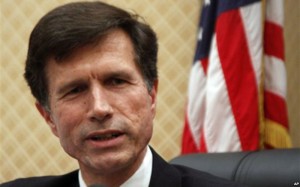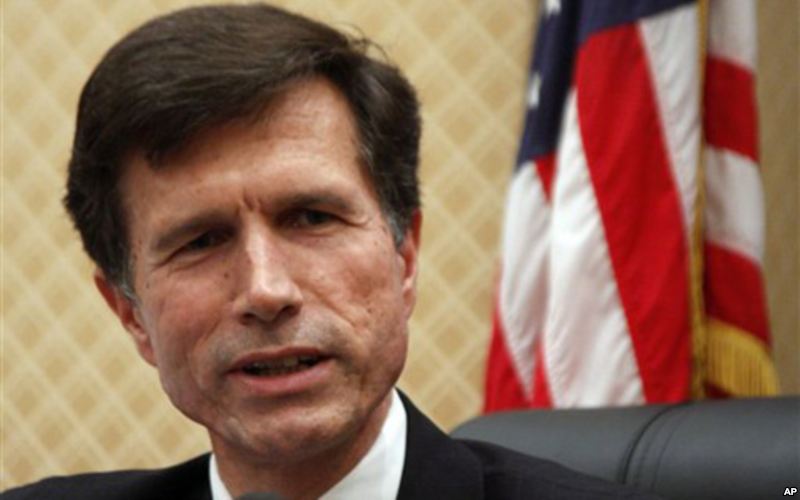 |
| Blake: Foreign investors face an uphill battle in Sri Lanka’s marketplace |
Remarks by Assistant Secretary Robert Blake at AmCham Luncheon
It is a great honor to be here with so many old friends at the American Chamber of Commerce. I would like to begin by thanking President Vijaya Ratnayake and the rest of the AmCham staff and Board of Directors, for hosting this event and bringing our focus to expanding trade and investment opportunities for the United States and Sri Lanka.
We have strong, important, and long-standing ties between our two countries. The United States was encouraged to see the end of the terrible conflict that divided Sri Lanka for so long. We now want to join Sri Lanka to look forward to pursue a better future for all Sri Lankans.
A key part of that will be the implementation of the LLRC recommendations, to ensure a democratic, just, secure, and prosperous future for all Sri Lankans.
A strong economic partnership will be another important part of achieving that vision. Since Sri Lanka’s independence, we have worked through the United States Agency for International Development to provide over 2 billion dollars in assistance, including in response to the tsunami and to the needs of internally displaced persons. USAID has established Public-Private Alliances with Sri Lankan companies to expand operations into the North and East to create new opportunities and better livelihoods. These partnerships are helping to re-activate the local economies of the North and East and laying the groundwork for sustainable economic growth that provides opportunities for all Sri Lankans. We believe that creating economic opportunity must go hand in hand with political reconciliation.
We are also important trading partners. As you know, the United States is the largest single export destination for Sri Lankan goods, with over 20% of your exports. This year, we resolved a GSP case with Sri Lanka, preserving valuable trade opportunities for Sri Lankan exporters. The United States actually has a large trade deficit with Sri Lanka, as we imported over 2 billion dollars in goods last year while exporting only $300 million dollars worth of goods to Sri Lanka. That’s a balance of $1.7 billion dollars every year in Sri Lanka’s favor!
We want this trade relationship to grow, and that is why we are strong advocates for U.S. companies here in Sri Lanka. We see opportunities for U.S. companies in sectors ranging from tourism and infrastructure development to information technology. The economy has grown by 8% annually in the last two years, and we hope to see continued strong growth. And Sri Lanka’s free trade agreement with India offers numerous export opportunities into that huge and expanding market.
Sustained economic growth requires greater foreign direct investment and continued expansion of the export sector. We are continuing our Trade and Investment Framework Agreement, or TIFA, talks, which can open and encourage foreign direct investment in Sri Lanka. The new TIFA Labor Sub-Committee will help ensure that any labor concerns are resolved quickly, hopefully avoiding future GSP problems.
But in the three years since the end of the conflict, to be frank, we have not seen very many new U.S. companies come to invest in Sri Lanka. It’s not for lack of trying, but our investors, and investors from many other countries as well, face an uphill battle in Sri Lanka’s marketplace. The barriers include confusing and opaque rules on bidding for contracts, unpredictable government regulations such as the recent so-called Under-utilized Assets bill, and corruption. Sri Lanka moved up the World Bank’s Ease of Doing Business rankings from 98 to 89 in 2012, but actually lost ground in several key categories, including the ease of starting a business, dealing with construction permits, and registering property.
The government has made progress in developing ports, aviation, and other infrastructure. But these are not enough to realize the true potential of the Sri Lankan economy. The time is right to think about how to help launch in Sri Lanka the type of large-scale economic growth that India experienced through market openings in the early 1990s. You have the human resources, and you are building the infrastructure. With more aggressive reduction of tariff and non-tariff barriers, and liberalization of the rules for foreign direct investment, I am confident that the economy, and our bilateral trade and investment, can grow even more quickly.
I am aware that such changes do not come easily. Entrenched interests resist change. But the benefits are worth the effort, and it is very much in the interest of the business community to help promote such changes. The United States will do its part by continuing to advocate for trade and investment in Sri Lanka, and we look to our partners to join in this effort that will help build a more democratic, secure, and prosperous future for both of our countries.
September 14, 2012
[As prepared]
US EM
